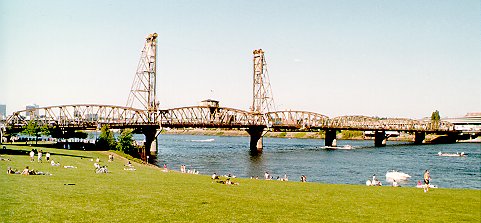

Water Environment Services of Clackamas County in order to better understand the water quality changes in the Lower Willamette River, have contracted with Portland State University (PSU) to develop a hydrodynamic and water quality model of the Lower Willamette River from Canby Ferry (RM 35) to the Columbia River and the Lower Columbia River from Bonneville Dam (RM 144) to RM 54. This model development was undertaken to develop a scientific approach to understanding the effect of Clackamas County's Tri-City discharge and other dischargers to the Lower Willamette River. The first phase of the project is to develop and calibrate the model then use it to run managment scenarios for Water Environment Services.

Parameters of Interest
- Hydrodynamics
- Temperature
- Dissolved Oxygen
- Nutrient Dynamics
- pH
- Algae Concentrations
- Bacteria
Introduction
The Willamette River system is a 11,500 mi2 watershed and drains through the Lower Willamette River from RM 0 to RM 35 (Canby Ferry), Figure 1. The river passes through the Portland metropolitan area before its confluence with the Columbia River at Columbia RM 106. The Columbia River is tidally influenced from the Pacific Ocean to the tailrace of the Bonneville Dam at RM 145. The Lower Willamette River is also tidally influenced from RM 0 (confluence with the Columbia) to the Oregon City Falls at RM 26.8
Water Environment Services of Clackamas County is in the process of planning upgrades on several of its sewage treatment plants which discharge into the Lower Willamette River. The goals of the modeling effort are to:
· Gather data to construct a computer simulation model of the Lower Willamette River system including part of the Lower Columbia River and the Willamette River above the Oregon City Falls; Because of the tidal influence in the Lower Willamette River, portions of the Columbia River that might affect the Lower Willamette River water quality were also modeled. Also, a section of the Willamette River above the head of tide, the Oregon City Falls, was modeled because of the lack of good boundary condition data at the Falls.
· Ensure that the model accurately represents the system physics and chemistry (flow, temperature, dissolved oxygen and nutrient dynamics);
· Use the model to evaluate how to meet various future discharge scenarios for the sewage district.
A hydrodynamic and water quality model, CE-QUAL-W2 Version 3 (Wells,
1997), is being applied to model the Willamette-Columbia system.
CE-QUAL-W2 is a two dimensional (longitudinal-vertical), laterally averaged,
hydrodynamic and water quality model that has been under development by
the Corps of Engineers Waterways Experiments Station (Cole and Wells, 2000).
In order to model the system, the following data were required:
· Willamette and Columbia River flow, water level and water quality
data
· Tributary inflows and water quality
· Meteorological conditions
· Bathymetry of the Columbia and Willamette Rivers and several
side channels
· Point source inflows and water quality characteristics
Many local, state and federal agencies have been collecting data in the Lower Willamette and Columbia Rivers. This report summarizes data used in the modeling effort.

Figure 1. Lower Willamette River Basin Region